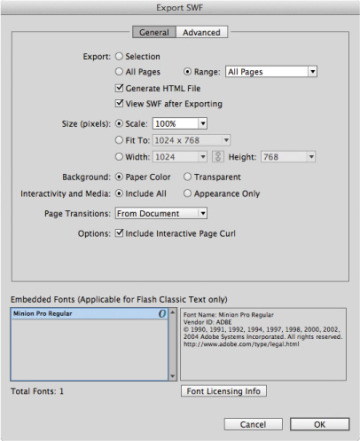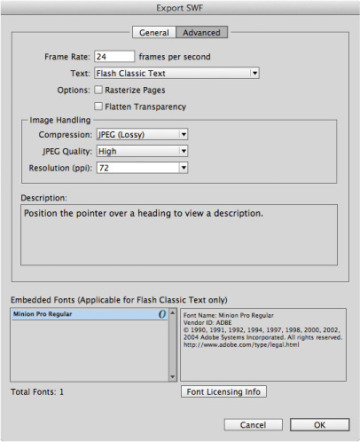SWF Export Options
SWF (pronounced swiff) is a format that, like PDF, can be used for the presentation of the entire InDesign file, with transitions from page to page.
In addition to the movies, sounds, and buttons found in PDF files, SWF files (commonly called Flash files) can contain the animations of page items from InDesign. SWF files cannot, however, contain PDF forms. As easy as it is to create these SWF animations and pages, you are somewhat limited as to where you can use them.
- The native animation effects won’t play in exported PDF files. They have to be exported as SWF videos and then placed on the InDesign page (see Chapter 8, “Interactive PDFs”).
- Apple doesn’t support the SWF format for its iOS devices, such as the iPad and iPhone.
- Adobe no longer makes the Flash Player that runs SWF files on Android devices.
- InDesign animations need to be converted to HTML5 in order to be used in DPS apps.
Despite these limitations, there are still legitimate reasons to convert InDesign documents to SWF files.
- They are very easy to create, without the need to learn any code.
- They create exciting presentations that can be played on a desktop computer or on a website. One of us worked with a client who created a private URL for a SWF presentation pitch to a client. The presentation used InDesign’s animation effects with great success.
To export an InDesign document as a SWF file, choose File > Export and then choose the Flash Player (SWF) format The Export SWF dialog appears.
General tab
Click the General tab to display the first half of the Export SWF dialog. These are the basic options, most of which will be familiar from other InDesign export dialoges.
Export: controls how many and which pages you want to export. Choose All Pages or Range to export all the pages in the document or a range of pages. In addition to exporting pages, you can convert just the selected objects on a page into a SWF file by clicking the Selection radio button.
As mentioned, SWF files are great for web pages. However, in order to be seen within a computer’s web browser, they need to be inserted into an HTML page. The Generate HTML File command creates a separate HTML file that contains the code necessary to insert the SWF into a web page.
Once you choose to generate the HTML file, you can then select the option View SWF after Exporting. You can’t select that option without generating the HTML file. The HTML file will always be used to open the SWF in the default browser on your computer. (Your default browser is whatever browser you selected in your computer or browser settings.)
The browser must have the Flash Player extension installed in your browser to play the SWF file. If you have trouble playing SWF files, go to http://get.adobe.com/flashplayer/. That page will read your operating system and browser and display the correct download for your computer.
Size (pixels): lets you change the dimensions of the SWF. You can choose to scale the animation by entering an amount in the percentage field or you can use the Fit To menu to choose from some of the more common monitor dimensions, such as 1024 x 768 or 1280 x 800. You can also use the Width and Height controls to pick a specific size. Changing the dimensions of the SWF is very helpful when you need a presentation to fit precisely in a specific monitor resolution.
Background: controls what is behind the elements of the SWF file. Paper Color uses the color Paper from InDesign’s Swatches panel. Use this setting when you want the animation to be easiest to read or to stand out from the browser. Transparent allows the background color of the web page to show in the empty areas of the animation. Choose this when you want the animation to blend in to the rest of a web page.
Interactivity and Media: is the same as the one for exporting a PDF (covered in Chapter 8, “Interactive PDFs”). Select Include All to keep hyperlinks, buttons, and media active in the SWF. Choose Appearance Only to keep only the graphics for those items, without the interactivity.
Page Transitions: allows you to control the transitions applied to pages in the document. (For more on page transitions, see Chapter 8, “Interactive PDFs.”) From Document keeps the transitions applied to the document. The None option turns off any transitions that were applied. You can also choose a new option from the transitions list to change the transition applied to all the pages.
Advanced tab
The Advanced tab of the Export SWF dialog lets you control additional options, including timing, text conversion, image resolution and compression, and font embedding.
Frame Rate: controls the smoothness of the animation. The higher the number, the more smoothly the animation will play.
Text: lets you choose one of three settings for how text is handled in the exported SWF. When you choose Flash Classic Text, the text is kept as font (vector) information, which makes the file size small. However, there may be times when the font information doesn’t translate correctly to the exported SWF. This causes certain characters to be dropped from the text or to be converted to the wrong glyphs.
In those situations, choose one of the other options in the Text menu. Convert to Outlines converts the fonts to their vector shapes. This option increases the file size slightly. Most likely this will solve your missing characters or glyph problems.
However, if you still have problems, choose Convert to Pixels. This rasterizes the text from vectors to a bitmapped image, which results in a larger file. This option should only be used as a last resort, when converting to outlines doesn’t work correctly.
Embedded Fonts (Flash Classic Text only): If you’ve got text in your document, you’ll see a list of the fonts at the bottom of the dialog that have been embedded in the file. Most of the time, this will be a complete list of all the fonts in your document. However, some font publishers put code in their fonts that prevents them from being embedded in a file for export in a streaming animation. If that happens to your text, you need to change the font. Check the licenses of the fonts you are using for more information on what you can and cannot do with the font. For instance, you may be tempted to convert the font to vectors or pixels to avoid font licensing problems. But even that may be prohibited by the font licensing agreement.
Options: If you want a bitmapped picture of your animation that doesn’t move, doesn’t respond to mouse clicks, and basically just sits there like a bump on a log, select Rasterize Pages. The option removes all interactivity from your exported SWF. It is used for multi-page documents that are going to be presented using Flash Player. And even then, you should only apply the setting if you can’t get the SWF to work correctly without the option applied. Basically, it’s a last-resort measure to get the SWF to export. Because the option converts vector objects into bitmapped images, the option also increases the file size of the SWF.
The same warnings apply to the Flatten Transparency option. This setting removes all motion and interactivity from the document. It should be used only if the transparency effects, such as drop shadows or transparency PSD files, aren’t exporting correctly in the SWF. It can’t be used for motion animations, but it can be used for multi-page presentations.
Image Handling: for exported SWF files are the same as the options for exporting images in a PDF. (See Chapter 8, “Interactive PDFs” for more information on these settings.)
Previewing without exporting
You may want to check the result of various options as you apply them in the Export SWF dialog. If you export a file each time, you will constantly have to go through the steps to create a SWF, and you may also litter your desktop with files as you test the export settings.
As discussed earlier in this chapter, you can use the SWF Preview panel to preview animations or presentations. You can also choose Test in Browser from the SWF Preview panel menu. This opens your default browser and displays the animation without creating a file.
Exporting FLA Files
There is one more option for working with animation files. Instead of exporting as a SWF that is ready to be placed into a web page or PDF, you can export the document as a native Flash (FLA) file. This is the format that Flash developers use to create their Flash web pages and games.
Choose the Flash CS6 Professional (FLA) from the export format menu. The Export Flash CS6 Professional (FLA) dialog appears. These are the same settings as the Export SWF dialog with two differences. An additional option for text, Flash TLF (Text Layout Framework) Text, is offered for the Flash developer. If you choose the Flash TLF option, Insert Discretionary Hyphen Points is available. This prepares your text so it can be hyphenated.
Now before you get too excited about exporting as FLA files, be aware that the presets, timing, and actions for the animation are not converted as expected. Each spread is mapped to a new keyframe, and animations are visible in the Flash Library only as movie files that are set to loop continuously. This makes the file extremely complicated to edit.

